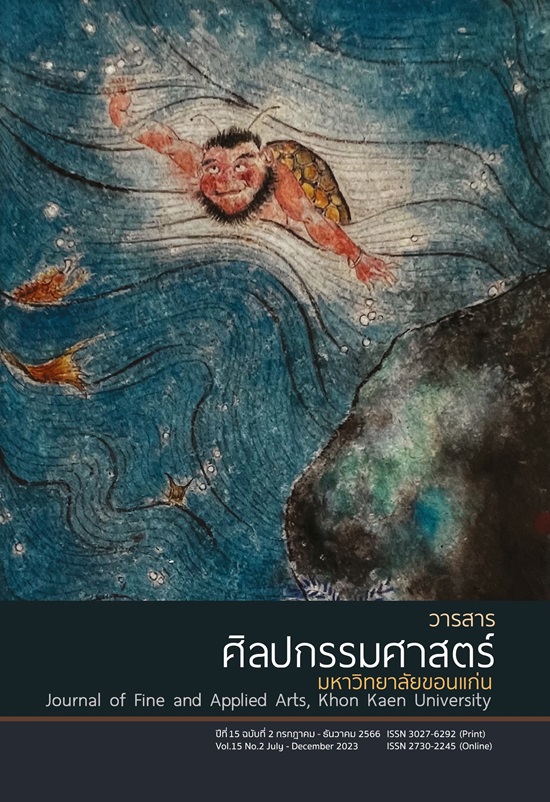The Study of Knowledge and Skills for Storyboard Artist
Main Article Content
Abstract
The purpose of this research is to study knowledge and skills for storyboarding careers in Thailand by using a mixed methods research with a questionnaires and in-depth interviews from key informants. The statistics used in the research were descriptive statistics. It was the analysis of general data characteristics. Display the measurement in terms of mean values, i.e. mean, percentage and standard deviation to describe the results. The research population is professional storyboard artists in Thailand 10 person by using the tools used to collect data include: questionnaires and interviews which the operating procedure is Study and find information to design and develop tools for creating questionnaires and interviews. The generated assessment is then taken to an expert for review for content fidelity. After that, the question-to-object correspondence index was analyzed. The results showed that Knowledge for a storyboarding career includes: knowledge of film theory art theory Composition and drawing skills are required. Sorted by the most important parts are data communication The storytelling was understood (𝑥̅=4.60), followed by drawing the human movements (𝑥̅=4.00), followed by drawing the human face (𝑥̅=3.80), which was as important as the scenery. Camera angle and camera movement are just as important as the continuity of the shot (𝑥̅=3.70). The medium and long distances in the image were equally important as the image size (𝑥̅=3.60). Composition (𝑥̅=2.90) The low evaluation scores were editing (𝑥̅=2.60) and 180 degree lines (𝑥̅=2.00). Screen size (𝑥̅=0.80), considering the light source (𝑥̅=0.70), the least evaluation level is to take into account the realistic lighting and shadows and the use of color (𝑥̅=0.60).
Article Details

This work is licensed under a Creative Commons Attribution-NonCommercial-NoDerivatives 4.0 International License.
Content and information in articles published in the Journal of Fine and Applied Arts of Khon Kaen University is regarded as the opinion and sole responsibility of the author(s) directly; therefore, editors are not obliged to agree to or share any responsibility with regard to the content and information that appears within these articles.
All articles, information, content, image, etc. that have been published in the Journal of Fine and Applied Arts of Khon Kaen University is the copyright of the Journal of Fine and Appllied Arts of Khon Kaen University. Any person or organization who wishes to distribute all or parts of the articles for further dissemination or other usage must first receive permission from the Journal of Fine and Applied Arts of Khon Kaen University before proceeding to do so.
References
ภัทรนันท์ ไวทยะสิน. (2559). “ภาพ” รากฐานการสร้างสรรค์ สื่อสาร เล่าเรื่องในงานภาพยนตร์.วารสารวิชาการนวัตกรรมสื่อสารสังคม, 4(2), 28-33.
เลอสม สถาปิตานนท์. (2537). What is design. กรุงเทพฯ : 49 กราฟฟิค.
สุทิน ชนะบุญ. (2549). สถิติและการวิเคราะห์ข้อมูลในงานวิจัยด้านสุขภาพเบื้องต้น. ขอนแก่น: สำนักงานสาธารณสุขจังหวัดขอนแก่น.
Cavalier, S. (2011). The world history of animation. London : Aurum Press.
Fraioli, J. (2000). Storyboarding 101: A crash course in professional storyboarding. Michigan : Michael Wiese Production.
Glebas, F. (2009). Directing the story. New York : Focal Press.
Hahn, D. (2008). The alchemy of animation. New York : Disney editions.
Hart, J. (2008). The art of the storyboard: A Filmmaker’s introduction. Oxford : Focal Press.
Thompson, R. (1998). Grammar of the shot. Oxford : Focal Press.
Tumminello, W. (2005) Exploring storyboarding. New York : Thomson Delmar Learning.
Vardanega, V. (2013). Pixars animation process. Retrieved July 1, 2022. from http://pixar-animation.weebly.com/pixars-animation-process.html
Wells, P. (2006). The fundamentals of animation. New York : AVA Publishing.


